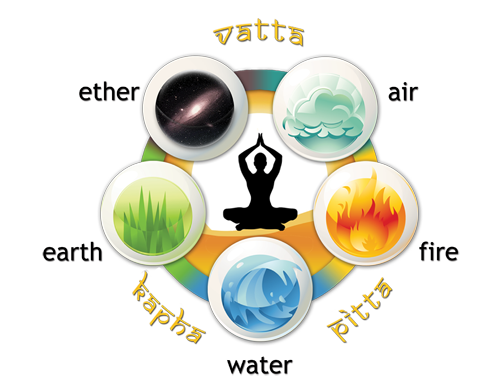
What is Tridosh
In Ayurveda, all the biological organisms and processes occur due to three energetic principles. All of these combined make up tridosha. All the three doshas are formed by the a combination of two, out of the five universal elements: which are; earth, water, wind, fire and space. Every being, whether human or not is born with a unique balance of tridosha; which is called his prakriti. Also, all the bodily systems, psychological and spiritual phenomena are governed by these alone.
- The tridosha includes :
- 1. Vata 2. Pitta 3. Kapha
- Vata- the catabolic dosha
-
Vata is the combination of wind and space; this makes mobility its principle characteristic. According to the tridosha theory, this dosha is associated with all the movement in the body, may it be spiritual like flow of thought; or physical like blood flow in our veins. One major function of this is the flow of neural impulses. In addition to these major functions, Vata also controls and governs the other two doshas. This means that achieving balance of it is the first priority. Since this dosha is characterized by movement, it can get easily unbalanced as compares to the other two.
The five sub-doshas of Vata includes :
Prana- controller of the senses, is found in the head;
Udana- controls voice and intellectual abilities, is found in the chest area;
Vyana- controls all the controlled bodily actions, is found in the heart;
Apana- controls discharges through the urinary tract, is found in the anal region, and
Samana- controls digestive processes, is found in the stomach. - Pitta- the metabolic dosha
-
Pitta dosha is formed by the synergy of fire and water. The fire symbolizes its relation with energy and the changes it goes in the body. All the processes pertaining to metabolism, changes and heat in the body are governed by Pitta. The change can be mental, as well as physical. The main role in it are digesting food, and using it to make energy. Others include the judging capabilities and the power or perception.
This is further divided into five sub-categories: :
Ranjak- production of Rakta or blood and is found in the stomach;
Aalochak- provision of sight, and is found in the eyes;
Sadhak-although found in the heart, it governs the psychological capabilities;
Pachak- located in the duodenum part of the small intestines, it mainly maintains digestive functioning, and
Bhrajak- found in the skin, it controls skin pigmentation. - Kapha- anabolic dosha
-
Being the synergy of earth and water, the third dosha is associated with the stability possessed by the earth, while being the fluid humor. The role of this dosha is to provide structure and vitality to the mind and body. It also governs the water content of the body, even at the cellular level; and filling the empty parts of the body. At a psychological level, this dosha is associated with primal emotions like love, envy, forgiveness etc.
The further sub-classifications of this dosha are: :
Kledak- for assimilation of food, and is found in the stomach;
Shleshak- for lubrication of joints, and is found in all the joints of the body;
Tarpak- governs intelligence, and is found in the head;
Avalambak- lubricated the heart and throat, and is found in the chest;
Bodhak- governs and is found in the sensory organ of taste.
To know your TRIDOSHA base constitution please contact us… Contact us